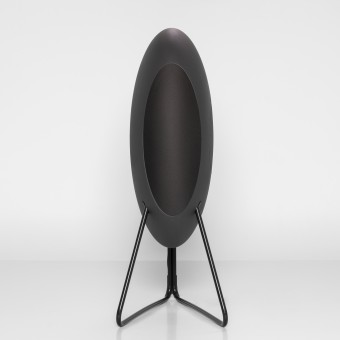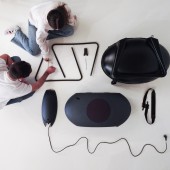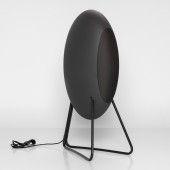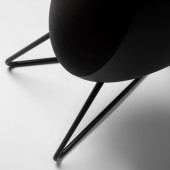
| THE AWARD |
| CATEGORIES |
| REGISTRATION |
| SUBMIT YOUR WORK |
| ENTRY INSTRUCTIONS |
| TERMS & CONDITIONS |
| PUBLICATIONS |
| DATES & FEES |
| METHODOLOGY |
| CONTACT |
| WINNERS |
| PRESS ROOM |
| GET INVOLVED |
| DESIGN PRIZE |
| DESIGN STORE |
| THE AWARD | JURY | CATEGORIES | REGISTRATION | PRESS | WINNERS | PUBLICATIONS | ENTRY INSTRUCTIONS |
Musegg Individual Fitted Sound System by Jürgen Seidler |
Home > Winners > Design #152113 >Interview |
 |
|
FS: What is the main principle, idea and inspiration behind your design?
JS: There are many products in consumer electronics, especially for loudspeakers. The main goal while making Musegg was to transform the understanding of value as it's understood now—like the value of gold, the value of real estate, or the value of a house—into a new understanding of value. Value as a function that delivers something to me.
FS: What has been your main focus in designing this work? Especially what did you want to achieve?
JS: It's a combination of life integration and artwork. For me, integrating into a customer's life means prioritizing functionality and upgradability throughout the product's lifetime. The principle of design following function creates good, functional designs. We wanted to shift this paradigm by potential future functionality as part of the present function. This is what led to our modular design.
FS: What are your future plans for this award winning design?
JS: We are just starting to market the product. We are also working on ensuring that the smaller version of our latest product, Musegg, will feature a 360-degree lighting system. This will undoubtedly elevate the product to the next level, but it also presents some significant challenges with light management, maintenance, and industrialization. The learning curve is quite steep at the moment.
FS: How long did it take you to design this particular concept?
JS: We started 5 years ago with requirements engineering and artwork. The artwork took us around 2 months. After finishing the first prototype and receiving much feedback, we redesigned the hardware and software architecture, which also had massive impacts on the artwork. There were some slight reworks in the architecture due to improvements identified while building up Series 0. So, overall, we spent more or less four years working on Musegg.
FS: Why did you design this particular concept? Was this design commissioned or did you decide to pursuit an inspiration?
JS: Some of my equipment broke down, and I wasn't able to repair it, so I had to start researching how to replace it. I found that there is no product that meets my expectations in both audio quality and design simultaneously. While Bluetooth speakers offer excellent industrial design, usability, connectivity, and decent sound at an affordable price, premium HiFi, also known as high-end, still adheres to its traditional setup of multiple separate components. One function per device, just as it was 30 years ago. This market observation inspired us to reimagine premium HiFi for a new generation. It should offer excellent design without occupying much space, be easily accessible for trial, be customized to the user's audio preferences, and seamlessly integrate into users' rapidly evolving environments.
FS: Is your design being produced or used by another company, or do you plan to sell or lease the production rights or do you intent to produce your work yourself?
JS: We produce it ourselves with the help of some great partners. We are just beginning with the marketing and are still looking for good partners for this.
FS: What made you design this particular type of work?
JS: Alongside the breakdown of my own beloved equipment, which had served well for decades, there was a realization from a past project I did for the brand Carboton, where I designed a speaker enclosure from fiber-reinforced composites. This particular design was too polarizing; it mainly attracted men. This opened up a discussion, leading to the requirement for the design to be more inclusive and not to polarize.
FS: Where there any other designs and/or designers that helped the influence the design of your work?
JS: To pick just one, Marcel Breuer inspired us with his timelessly modern furniture designs.
FS: Who is the target customer for his design?
JS: Our product is tailored for the design-savvy music lover. We have developed a digital product that focuses not only on quality and performance but also on sustainability and resource conservation.
FS: What sets this design apart from other similar or resembling concepts?
JS: There are two main points of differentiation that are unique worldwide. The first is our understanding of sustainability, realized through a modular concept that we communicate as allowing for value-retaining consumer electronics. This approach enables users to replace rapidly developing electronics by simply swapping out one module for another, without requiring any technical knowledge. The second is an ultra-personalization through a remote service where the device is customized to the customer's needs. Our audio design philosophy centers on the human being and their individual hearing characteristics. Our habits and experiences shape our perception of sound. Therefore, everyone perceives music differently and has unique preferences. The environment in which we listen significantly affects the playback. Our individual fitting service, guided by an audio specialist, analyzes your room acoustics and creates a fitting tailored to your preferences, regardless of where you are in the world.
FS: How did you come up with the name for this design? What does it mean?
JS: The name came up naturally. After struggling for months to find an appropriate name, we showed it to the public, and everyone referred to it as an egg. Being a sound system meant to play music, the name "music-egg" or "musegg" was given.
FS: What is the most unique aspect of your design?
JS: It's definitely the personalization service as part of our audio design, which is completely new to the industry and could offer a fresh perspective to an industry that is currently struggling to find a new direction.
FS: Who did you collaborate with for this design? Did you work with people with technical / specialized skills?
JS: As soon as we began industrialization, we partnered with experts who contributed their knowledge to help us develop the necessary details.
FS: What is the role of technology in this particular design?
JS: Technology plays a major role in musegg. The development of connected streaming services like Spotify Connect and TIDAL Connect made our development possible. The advancements in industrial computers and operating systems enabled the kind of sound processing we implement like the devices ability to be really (not just EQs) fitted to a unique user.
FS: Is your design influenced by data or analytical research in any way? What kind of research did you conduct for making this design?
JS: Shaping something the size of a barrel in a fresh and captivating manner posed a significant challenge. After countless design drafts, the elliptical design emerged, with proportions balanced by the golden ratio. From a mechanical and acoustic design perspective, this shape has great advantages, which we knew from theory and proved with extensive FEM analyses. This led to an enclosure architecture with an unprecedented weight-to-stiffness ratio, reducing the material used and enabling easy shipping.
FS: What are some of the challenges you faced during the design/realization of your concept?
JS: Developing a manufacturing process for the enclosure, where 8 thermoplastic parts can be seamlessly and flawlessly assembled into a monocoque and easily coated with an ultra-matte finish, making the silhouette appear even slimmer. Creating a process for remote interaction between the user and an audio specialist with synchronous data transfer. While collecting the customer's needs, the specialist can view user data, analyze it, and create an acoustic fitting, which the user can set up on-site.
FS: How did you decide to submit your design to an international design competition?
JS: I'm not a designer as you might think. I'm more of a crossover between a data-driven engineer and an industrial designer. So it “happened.” First, I was just curious and uploaded some photos without extensive descriptions for preliminary judging and nearly forgot that I did. Some weeks before closing, I received an email with an invitation to attend. It wasn’t an automated one but contained some personal words, which gave me the confidence to participate.
FS: What did you learn or how did you improve yourself during the designing of this work?
JS: We learned that artwork and concepts are good, but functional and life-integrating design is much more. A design concept is the beginning, leading to various disciplines like mechanical engineering, hardware engineering, software engineering, logistics, quality, and more. We learned that classical project management makes no sense for such large projects. It is much more effective to have these disciplines work in parallel and make small agile iterative progress.
FS: Thank you for providing us with this opportunity to interview you.
A' Design Award and Competitions grants rights to press members and bloggers to use parts of this interview. This interview is provided as it is; DesignPRWire and A' Design Award and Competitions cannot be held responsible for the answers given by participating designers.
| SOCIAL |
| + Add to Likes / Favorites | Send to My Email | Comment | View Press-Release |





